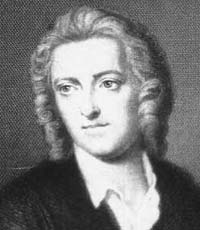Sestet
a six-line stanza. Most commonly, sestet refers to the second division of an Italian sonnet.
Sonnet On the Death of Mr. Richard West
Thomas Gray
In vain to me the smiling mornings shine,
And redd’ning Phoebus lifts his golden fire:
The birds in vain their amorous descant join;
Or cheerful fields resume their green attire:
These ears, alas! for other notes repine,
A different object do these eyes require:
My lonely anguish melts no heart but mine;
And in my breast the imperfect joys expire.
Yet morning smiles the busy race to cheer,
And new-born pleasure brings to happier men:
The fields to all their wonted tribute bear;
To warm their little loves the birds complain:
I fruitless mourn to him that cannot hear,
And weep the more, because I weep in vain.
Thomas Gray’s “Sonnet On The Death Of Mr Richard West” consists of an octave and a sestet. The octave contains the first eight lines of the poem, while the sestet includes the remaining six lines. A sestet is a six-line stanza, and it most commonly refers to the second division of an Italian sonnet. The sestet in this particular poem contains the lines from “Yet morning smiles the busy race to cheer,” to “And weep the more, because I weep in vain.”

"Poetry is thoughts that breathe, and words that burn." ~Thomas Gray
Thomas Gray

Thomas Gray was born on December 26, 1741 at 41 Cornhill, London, near St. Michael's Church in a small milliner's shop kept by his mother. He was the fifth out of twelve children to Dorothy and Philip Gray, however the only surviving child.
His father was a "money-scrivener" that had married Dorothy Antrobus in 1709 and moved in the Cornhill house. Philip was very abusive to Dorothy, causing Thomas to have a very troubled childhood. Due to this, Thomas was sent to Eton College in 1725 where his uncle Robert, at Peterhouse, Cambridge, cared for him and his education.
While at Peterhouse, Gray began to write Latin verse. His habits were studious and reflective. He and his friend Walpole, the son of prime minister Sir Robert Walpole, would send poems to Richard West, whose father was a Lord Chancellor of Ireland, in English and occasionally French and Latin. The three together contributed to hymneals to the marriage of Frederick, Prince of Wales, which later published as Gratulatio in 1739.
In 1738, Gray left Peterhouse without having degree. He left to stay with his father in Cornhill, probably to study law at the Inner Temple who admitted him in 1735. However, he inherited a modest property from his aunt Sarah and enjoyed financial freedom.
Much of the coming years were spent at Peterhouse, reading, studying, taking part in summer tours and surrounding himself with his circle of friends while writing admirable letters. He did not take part in courses at the university, but resided there as a gentleman of leisure and took advantage of the intellectual amenities.
While journeying to Switzerland in the summer of 1771, Gray suddenly fell ill. He returned to London, then soon to Cambridge where his health worsened. With an attack of gout in the stomach, his condition became alarming.
On July 30, 1771, Gray died in his room. He was laid to rest in the same vault as his mother in the churchyard of St Giles at Stoke Poges on August 6. Exactly seven years later on August 6, 1778 a monument was erected in memory of Thomas Gray in Westminster Abbey. The monument is located in Poets' Corner just Milton's and next to Spenser's, the two poets Gray admired most. In 1799 another monument to Gray's memory was placed adjoining the churchyard at Stoke Poges. Other memorials were set up years later in Eton College and Cambridge.
(http://www.poemofquotes.com/thomasgray/)
